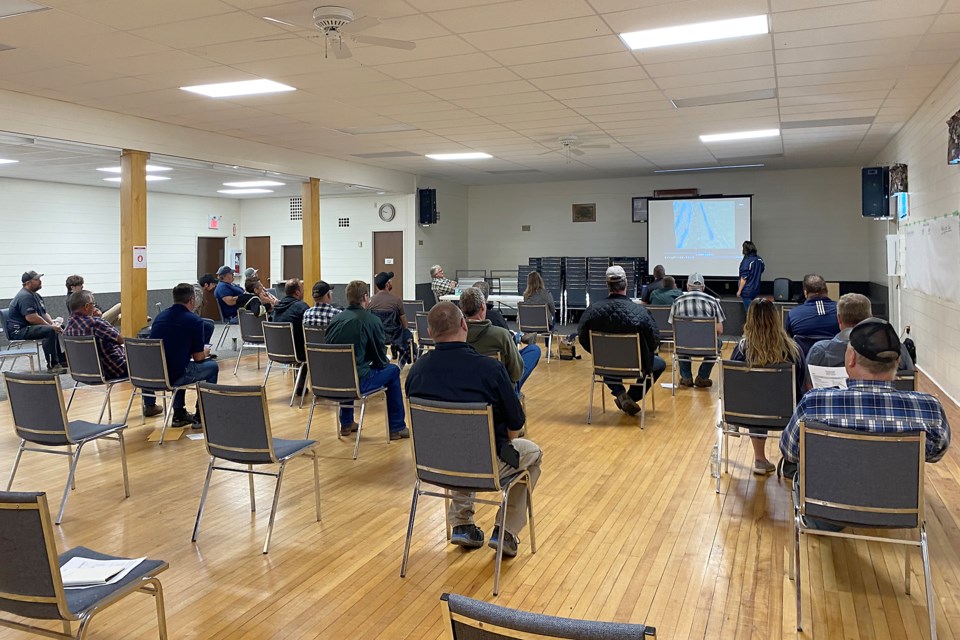WESTLOCK - Farmers around Lebeaus Lake are willing to put in the work to fix some drainage issues after significant flooding left upstream and downstream landowners with unusable land.
That’s what came out of a Sept. 10 meeting, organized by downstream farmer David Woynorowski at Pibroch Hall, where 21 other farmers, Westlock County and Alberta Environment and Parks officials spent close to three hours covering existing infrastructure, issues and required permits for operating release valves.
Flooding at Lebeaus Lake is not exceptional in the county or the province. As one Ducks Unlimited representative put it, “There’s flooding everywhere.” The organization operates the release valve on Lebeaus Lake and representatives were present at the meeting.
But it is historically new. Structures that were put in place 50 to 60 years ago were meant to store water or keep it in. The problem now is that none of the infrastructure is prepared to accommodate current water levels.
As downstream landowners experienced it, releasing water from Lebeaus Lake ends up flooding their lands. The current channel that carries water released from Lebeaus Lake into Dapp Creek hasn’t been maintained, they say, so water spills or seeps onto farmland.
Woynorowski had pictures of flooded pastures, and one farmer said he’s had to move his cattle because of the water.
Ultimately, they think that water shouldn’t be released from the lake unless it can stay in the county’s channels and Dapp Creek — they questioned the county’s authority under the current licence for the control structure to let water out if it floods private land.
To get rid of water on private land, some of the downstream farmers also built their own ditches to let water out, most without permits from AEP — they’re required under the Water Act but compliance officer Tricia Coates said there is discretion there. Some of the ditches lead into the county’s channel, filling it with more water than it can handle.
It’s worth mentioning that in most people’s recollection, 2018 was the first time the release valve at Lebeaus Lake had water flowing through it. As Coates put it, it’s excusable that municipalities divested funds away from maintaining an unused channel since flooding infrastructure is “a budget issue.”
But for landowners bordering the lake, keeping water in is evidently causing flooding on good farmland.
“On our own land, it’s about 213 acres and another 88 acres of land we rent” that were flooded, said Nelson Jespersen, who owns Tuxedo Farms. He spoke for all upstream farmers.
Seemingly, this is what would have had upstream and downstream landowners at odds with one another: some want the release valve opened, others want it shut.
To Jespersen, it’s also not just a matter of how much they lose in land, but what seeps into the lake. As he put it, farmers use manure and some spray their crops — all that makes it into the lake if it floods past the Crown land surrounding it.
“It’s a great spot to live, we love the lake, we want to see the lake healthy, we don’t want it to go away. We want it managed properly,” he said.
“So, in order to understand what’s going on and have action, we think that it should involve all of us. And to say upstream and downstream, I mean, we’re all trying to farm land. The bottom line is we want to farm our title land … I like to put my hat on downstream too, to see what’s happening. I know the struggles, and when the water gets released, it’s more water onto your lands, and I realize that. But we have our own issues with excess water coming in too.”
Since July 17, Jespersen said one of the two gateways on the release valve structure has been open — he lives near it — to let out the 15 inches of excess water; six inches are still left to go.
The point of the meeting though, wasn’t to lay out grievances. Instead, farmers wanted solutions.
Jespersen proposed, in order, cleaning out Dapp Creek starting downstream, moving into the channel; installing proper cattle crossings across the channel; proper permitting processes for private ditches “so that our kids don’t have to deal with it;” installing a proper water-level indicator for objective measurements with clear levels for opening the valve; and establish the proper level of the lake, including surrounding Crown boundary.
“That way, it’s set at the right level, whatever amount of surge you want to hold in there and it’s not flooding title land, we’re good. That’s all we ask.”
Finally, Jespersen asked that a proper riparian area be established on the Crown boundary between the lake and farmland.
Most of this appealed to the downstream landowners, who agreed to contribute manpower once all the permitting issues were worked out.
They were, however, at odds over one of the downstream solutions: removing the control device and allowing Lebeaus Lake to return to natural, historic levels “is not going to work for us,” said Jespersen.
Ultimately, this was left with Westlock County. Coun. Isaac Skuban and Coun. Dennis Primeau both attended the meeting.
“If you want to help the farmers out, that’s how you’re going to have to do things. You’ve got an obligation under your licence to monitor, measure, maintain, capsize as appropriate,” Woynorowski told the two councillors.
“I don’t want this studied, I don’t want this looked at, I don’t want this tabled. I want it brought to the next county meeting … The excuse ‘We don’t have the money’ doesn’t work.”
Andreea Resmerita, TownandCountryToday.com
Follow me on Twitter @andreea_res



